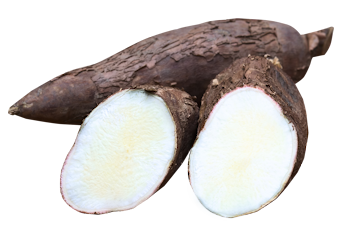|
Some of the most impressive health benefits
of arrowroot include its ability to promote growth and development, help with
weight loss goals, ease stomach issues, prevent birth defects, boost the
metabolism, increase circulation, reduce blood pressure, and promote a healthy
digestive system.
Arrowroot is not technically a plant in
itself, but rather a type of starch that can be readily obtained from the roots
of numerous different plants and rhizomes. This high nutrient density starch
has been very valuable to a number of indigenous cultures dating back more than
7,000 years, but despite the fact that so many herbal remedies have been
disproven or have gone out of use, arrowroot remains an important and effective
remedy for many different health conditions. It can be used as a replacement in
many foods, rather than flour or corn. Essentially arrowroot powder can be a
healthier alternative to the more common cooking ingredients for breads,
pastas, and cakes. Arrowroot is also gluten-free, which makes it all the more
valuable today with the rising incidence of Celiac disease in many countries.
One of the most common uses of arrowroot is
as a food thickener, but it can also be eaten on its own, even for infants in
their formula rather than other less nutritious forms of starch. You can eat
the root of these various tubers raw, roasted, boiled, or stewed without losing
the potency and nutrients. Now, let’s take a more in-depth look at the many
health benefits of arrowroot.
|
|
Health Benefits of Arrowroot
Some of the most impressive health benefits
of arrowroot include its ability to promote growth and development, help with
weight loss goals, ease stomach issues, prevent birth defects, boost the
metabolism, increase circulation, reduce blood pressure, and promote a healthy
digestive system.
Arrowroot is not technically a plant in
itself, but rather a type of starch that can be readily obtained from the roots
of numerous different plants and rhizomes. This high nutrient density starch
has been very valuable to a number of indigenous cultures dating back more than
7,000 years, but despite the fact that so many herbal remedies have been
disproven or have gone out of use, arrowroot remains an important and effective
remedy for many different health conditions. It can be used as a replacement in
many foods, rather than flour or corn. Essentially arrowroot powder can be a
healthier alternative to the more common cooking ingredients for breads,
pastas, and cakes. Arrowroot is also gluten-free, which makes it all the more
valuable today with the rising incidence of Celiac disease in many countries.
One of the most common uses of arrowroot is
as a food thickener, but it can also be eaten on its own, even for infants in
their formula rather than other less nutritious forms of starch. You can eat
the root of these various tubers raw, roasted, boiled, or stewed without losing
the potency and nutrients. Now, let’s take a more in-depth look at the many
health benefits of arrowroot.
Circulation Issues: The rich nutrient mixture found in arrowroot includes
significant levels of copper and iron. These two essential minerals are
important parts of red blood cells, which makes arrowroot very good for
preventing anaemia, which is characterized by weakness, fatigue, and cognitive
disorders. Furthermore, by increasing circulation, you encourage oxygenation of
your body’s organ systems and extremities, which can boost your energy levels.
Metabolic Processes:
The high concentration of vitamin B within arrowroot makes it an
important enzymatic and metabolic substance. The B-vitamin family is very
important in regulating processes throughout your body, from hormonal release
to circadian rhythms, meaning that you never want a deficiency in that department!
Birth Defects: One particular member of the B family of vitamins is folate, and
it is found in high levels within arrowroot. Studies have shown that folate is
important for expecting mothers, as it can help to prevent neural tube defects
in their unborn child. Folate is also an important factor in DNA synthesis and
healthy cell division, thereby promoting rapid healing and healthy growth.
Stomach Concerns: Celiac disease seems to be the new global pandemic, and as the
numbers continue to climb around the world, people are seeking gluten-free
alternative to traditional starches and wheat. Arrowroot is a gluten-free
substance, making it very popular in recent years, as it can prevent the
gastrointestinal discomfort, pain, and danger that those handling a gluten
intolerance must face every day.
Growth and
Development: As compared to other root vegetables and
starches acquires from tubers, arrowroot has a higher concentration of protein,
an essential component of any diet. By increasing our dietary intake of plant
proteins, which are easier to process than animal proteins, we can guarantee
healthy growth and development.
Weight Loss
Concerns: Arrowroot is extremely low in calories as
compared to other starches like yams, potatoes, or cassava. For this reason,
people trying to remain on a diet can get complex carbohydrates and a wealth of
nutrients, as well as a healthy dose of dietary fibre, and eliminate the desire
to snack between meals. Arrowroot fills you up and gives you the minerals and
vitamins your body needs.
Digestion: Dietary fibre is one of the most important parts of our
digestive process, as it helps move food through the bowels in an efficient
manner, while also stimulating the uptake of nutrients. It can eliminate issues
of constipation and diarrhoea, and manage blood sugar levels to prevent the
onset of diabetes. Finally, dietary fibre can help to clear out excess
cholesterol, further promoting cardiovascular health.
Heart Health: The significant levels of potassium found in arrowroot mean that
it can be a definite line of defence against heart-related issues. Potassium is
a vasodilator, meaning that it relaxes the tension in the blood vessels and
arteries, thereby lowering blood pressure and reducing your risks of
atherosclerosis, heart attacks, and strokes. Potassium is also known as a
cognitive enhancer, promoting the flow of oxygenated blood to the brain.
|

